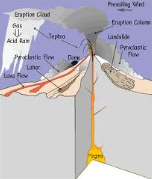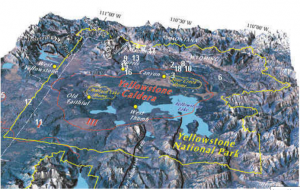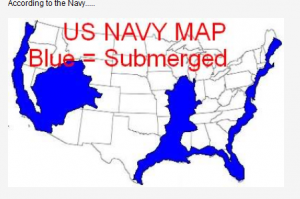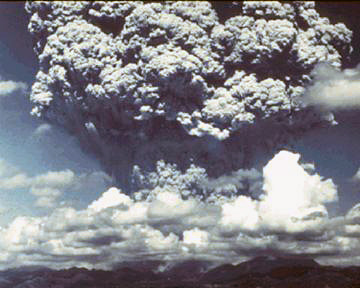Tag Archives: super volcano
DOOMSDAY 2012 – NATURAL DISASTERS COULD WIPE OUT YOUR ZOMBIE WORRIES
Floods, earthquakes, and volcanic eruptions. These are just a few of the natural disasters that may befall our planet between now and December 21st, 2012. As we speak, the summer solstice is upon us, but it’s the winter solstice that we should be worrying about.
Flooding. There are several different scenarios in which massive floods may overcome our planet. One is oceanic rise. If the oceans rise, the coastal areas of the world will recede, and millions of people living in these areas will either die or have to move further inland. Global warming is currently being blamed for the Greenland ice sheets and polar cap melt off that has been going on for years. I think the majority of people are skeptical of this diagnosis, or just don’t know what to think, as scientists seem to fall on both sides of this debate. What no one can dispute is that this is happening.

If solar flare/sunspot activity on 12/21/2012 should be great enough to gain entrance to our atmosphere on this day, it could accelerate the ice melt and the oceans will rise. If the temperature of the earth’s surface rises just a few degrees, this would also happen. How quickly, obviously no one knows. One thing rapid or even gradual ice melts will do is disrupt the thermohaline circulation of water in the Atlantic Ocean, an ocean-based system of heat delivery sometimes referred to as the North Atlantic thermal conveyor belt.
The northeastern States, eastern Canada and, primarily, Europe enjoy warmer climates than they otherwise would because of the thermohaline circulation. This vast ocean conveyor sweeps warm, salty water from tropical latitudes north along the surface. After shedding heat to the atmosphere, the chilled brine becomes denser and sinks. Thousands of feet beneath the surface it flows back toward the equator, completing the loop.
But as the climate warms disproportionately at the poles, the gears of the system begin to wobble. Freshwater runoff from Greenland’s ice cap and from melting glaciers across the Arctic, combined with increased precipitation, will form a thick, buoyant cap over the North Atlantic. Already, this gigantic vortex may be sputtering. The surface of the North Atlantic is becoming noticeably less salty, and thus less driven to sink.
 Thermohaline circulation shut down as recently as 8200 years ago, and some scientists contend that the Little Ice Age of 1300 to 1850 was due to a hiccup in the system. The chance of another collapse is hotly debated, in scientific circles, and may throw us into another Little Ice Age again.
Thermohaline circulation shut down as recently as 8200 years ago, and some scientists contend that the Little Ice Age of 1300 to 1850 was due to a hiccup in the system. The chance of another collapse is hotly debated, in scientific circles, and may throw us into another Little Ice Age again.
Earthquakes are a distinct possibility, and tectonic shift may occur. Tectonic shift and rise can be a direct result of earthquakes, as well as the weight and motion of melting water, among other things. It may well force the earth’s mantle to rise up and reform our planet.
Volcanic eruptions are a potentially catastrophic event that could be in store for us. The caldera at Yellowstone National Park, the World’s largest volcano, is said by scientists to be overdue for an eruption. This volcano is sometimes referred to as a Super volcano. There are over 3000 recorded earthquakes at Yellowstone National Park each year, and any sort of cataclysmic event on a worldwide scale may be the spark that  forces the caldera to erupt. That eruption, along with any others that may happen on that fateful day, 12/20/2012, would put enough volcanic ash into the atmosphere, as to blot out the sun for years, perhaps even decades. And then there are all the different types of gasses that will also be in the air, and oxygen purity levels will drop dramatically. Without Photosynthesis, a process whereby plants capture the suns energy to split off water’s hydrogen from oxygen. Hydrogen is combined with carbon dioxide to form glucose and release oxygen. If the sun is blotted out and plants can’t grow and capture carbon dioxide, while releasing oxygen, we may lose our ability to breath, among other things. This will also have a devastating effect on the global food chain. In my opinion, this will be the start of a fatal global downward spiral, from which there will be no return.
forces the caldera to erupt. That eruption, along with any others that may happen on that fateful day, 12/20/2012, would put enough volcanic ash into the atmosphere, as to blot out the sun for years, perhaps even decades. And then there are all the different types of gasses that will also be in the air, and oxygen purity levels will drop dramatically. Without Photosynthesis, a process whereby plants capture the suns energy to split off water’s hydrogen from oxygen. Hydrogen is combined with carbon dioxide to form glucose and release oxygen. If the sun is blotted out and plants can’t grow and capture carbon dioxide, while releasing oxygen, we may lose our ability to breath, among other things. This will also have a devastating effect on the global food chain. In my opinion, this will be the start of a fatal global downward spiral, from which there will be no return.
Last but not least. Again, in my opinion, the most probable occurrence will be an eruption of the volcano at Cumbre Vieja. Cumbre Vieja is an active volcanic ridge on the volcanic ocean island of Isla de La Palma in the Canary Islands, Spain. History has recorded volcanic eruptions of the Cumbre Vieja in 1470, 1585, 1646, 1677,m 1712, 1949, and 1971.
 During the 1949 eruption, three vents—Duraznero, San Juan and Hoyo Negro—opened and expelled massive amounts of lava. Also during the eruption two earthquakes happened centered near Jedey. Following the earthquakes a fracture appeared, approximately two miles long, about 1/10 of the exposed length of the Cumbre Vieja. Parts of the western flank of the Cumbre Vieja ridge moved about 1 mile sideways and 2 miles downwards towards the Atlantic Ocean. Scientists have hypothesized that an eruption or even an earthquake would send the western flank of the island sliding into the Atlantic Ocean, creating a Mega Tsunami of biblical proportions. Computer models indicate the resulting gravitational landslide will enter the Atlantic Ocean and create the so called Mega Tsunami, with the initial wave estimated at some 200 feet in height, and a peak to peak height of 1 mile. Estimated speed of the wave is 600 mph. It will reach the African coast in 1 hour, southern england in about 3 to 4 hours, and the eastern seaboard of the United States in about 6 hours. The initial wave will have subsided into a succession of smaller ones each about 100 to 200 feet in height, and may swell to 400 to 600 feet high at a distance of 1 to 2 miles apart, while retaining the original speed. Computer models indicate differing inland inundation measurements, between 15 to 30 miles or more according to the volume of water.
During the 1949 eruption, three vents—Duraznero, San Juan and Hoyo Negro—opened and expelled massive amounts of lava. Also during the eruption two earthquakes happened centered near Jedey. Following the earthquakes a fracture appeared, approximately two miles long, about 1/10 of the exposed length of the Cumbre Vieja. Parts of the western flank of the Cumbre Vieja ridge moved about 1 mile sideways and 2 miles downwards towards the Atlantic Ocean. Scientists have hypothesized that an eruption or even an earthquake would send the western flank of the island sliding into the Atlantic Ocean, creating a Mega Tsunami of biblical proportions. Computer models indicate the resulting gravitational landslide will enter the Atlantic Ocean and create the so called Mega Tsunami, with the initial wave estimated at some 200 feet in height, and a peak to peak height of 1 mile. Estimated speed of the wave is 600 mph. It will reach the African coast in 1 hour, southern england in about 3 to 4 hours, and the eastern seaboard of the United States in about 6 hours. The initial wave will have subsided into a succession of smaller ones each about 100 to 200 feet in height, and may swell to 400 to 600 feet high at a distance of 1 to 2 miles apart, while retaining the original speed. Computer models indicate differing inland inundation measurements, between 15 to 30 miles or more according to the volume of water.
This would greatly damage or destroy cities along the entire North American eastern seaboard, and tens of millions would be killed from Maine to Florida, and everything In between.
So there you have it. Not a pretty picture is it.
IF YOU THOUGHT ZOMBIES WHERE TOUGH – Try Surviving Yellowstone’s super volcano
For preppers, it’s the ultimate end game: surviving the eruption of Yellowstone’s super  volcano.
volcano.
While some folk worry about an asteroid strike bringing about the end of the world as we know it, as scientists say it did for the dinosaurs 65 million years ago, North America is actually sitting on its own extinction-level event waiting to happen.
“Everything would be wiped out; it would take years for the climate to recover and decades for the rivers to clear up because everything would be choked with volcanic ash for a wide area around the eruption site,” said Kelly Russell, professor of volcanology at the University of British Columbia. “The southern latitudes of Alberta, Saskatchewan and Manitoba would all see ash cover, how thick it would be depends on the winds and the amount of magma.”
Russell stresses that such super eruptions are extremely rare — the last one happened before human civilization — but that they can and do happen, and Yellowstone, in Yellowstone National Park in Wyoming, is an active field that has seen three massive eruptions.
He compares Yellowstone to Mount St. Helens in Washington state in 1980.
“It produced one cubic kilometre of magma, and we saw ash fall from it in southern B.C., a small amount, but it was there, and when we look at the very largest eruptions that have taken place at Yellowstone, they can spew out a thousand cubic kilometres, so that’s a thousand times larger than the Mount St. Helens eruption that’s in everybody’s minds.”
Russell points out that two feet of ash from the Crater Lake eruption in Oregon 7,700 years ago can be found in Oliver, B.C., and in the banks of the Bow River in Calgary. He says if Yellowstone cuts loose, the southern Canadian prairies could get covered in many feet of ash, and the American states closest to Yellowstone would be smothered with an even thicker layer of the sterile rock powder, killing off livestock and leaving them unable to grow food.
“The ash is terrible, take a window and grind it into a coarse flour, then breath that in, it does terrible things to the human body. It would be important to have masks and filters, if you were trying to survive it,” Russell said. “The United States would stop being a food-exporting nation and starting being a food-importing nation.”
Yellowstone’s volcano doesn’t have the classic menacing cone shape, so many people don’t know that a magma chamber bigger than New York City lies beneath the steaming surface.
640,000 years ago, animals similar to elephants, rhinoceroses and zebras roamed the plains of the United States when Yellowstone blew — and it took out the animals and every other living thing that couldn’t fly away from the blast.
Scientists estimate Yellowstone’s volcano explodes every 600,000 to 700,000, and some say the time could be coming for another eruption. If it blows, the chances of survival sound bleak, but that’s not stopping some survivalists from preparing.
“Some people who visit there say there are more hot springs popping up there, and there is more of a sulphur smell that’s stronger than ever. You take from it what you want and I just pay attention to it a little more than the average person, just in case,” said Jason Charles, a firefighter in New York City. “I don’t want it to be a curve ball we don’t see coming. I keep it in the back of my head.”
Charles was a paramedic on 9/11 and saw thousands of people struggling to breath through the toxic dust. He has special dust and ash filters for his gas mask in case of another NYC disaster, or if Yellowstone blows.
“I know some people who have bought UV lights, in case they need to grow their own food – but that’s also assuming that the power grid stays up, but then there’s a space issue, how much could you grow?” he said. “It’s better to store food that will last.”
Charles has a one-year supply of food for his family, including his wife and four children. Meal-ready-to-eats (MREs), canned pasta and lots of canned fruit are stuffed into his apartment and his storage locker. He prepares for all sorts of disasters because he says no one should depend on the government to save them.
“The government couldn’t handle (Hurricane) Katrina. Compared to Yellowstone, Katrina was a drop in the bucket,” he said. “I have always heard as a rumour, they would wait for the masses to die and whatever survivors are left, that’s who they’d take care of, because they can’t take care of hundreds of millions of people we have living here in the United States.”
Jake Lowenstern, a geologist with the U.S. Geological Survey, is the guy in charge of the Yellowstone volcano observatory.
“Worst-case scenario, a super eruption is a thousand cubic kilometres of material gets sent out of the magma chamber. When that happens it’s going to send out a lot of ash, and it circles the globe and changes the climate for years, drops the temperature for a few years,” Lowenstern said.
He said while a super eruption is highly unlikely, and even if it does happen not many would survive, it doesn’t hurt to prep.
“Things you can do to prepare for one kind of disaster are useful for any kind of disaster: lots of food, water, medical supplies and batteries on hand, and for an eruption, add good masks, air filters and weather stripping to keep the ash out of homes.”
Massive eruptions of the past:
— Archeologists say human beings barely survived the last super eruption on Earth. 74,000 years ago, Toba blew up on the Island of Sumatra. It cloaked the planet in sulphur, reducing the temperature by 20 degrees, wiping out growing seasons with snow cover nearly all year and causing mass starvation. Geneticists say the disaster reduced the human population to as few as 1000 people, thus causing the genetic similarity between individuals which is traced to the same time period.
— A volcanic eruption has been blamed for plunging civilization into the Dark Ages and triggering the bubonic plague. In his book Catastrophe, archeological journalist David Keys pinpoints a Krakatoa explosion in 535 AD. He says with the power of two billion Hiroshima bombs it darkened the sky and caused drought and flooding all around the world, including in Northeast Africa, which led to a bumper crop of rodents that passed their infected fleas onto rats and mice on European ships docked for trade off of southern Egypt, beginning the spread of the plague of Justinian.
— In 1815, the Tambora volcano erupted in the East Indies. Global temperatures dropped. Europeans and North Americans called it a “year without summer.” Snow fell in New York in June. Frost was recorded in each of the summer months and crops failed. 200,000 people died in Eastern and southern Europe from starvation and typhus.
— In 1783, Iceland’s Laki Volcano erupted. 9,000 people died in Iceland and thousands more died around the world from crop failure, disease and starvation. Temperatures dropped 13 degrees Celsius.
— Mount Pinatubo erupted in 1991 in the Philippines, a comparably small explosion, ejecting 20 million tonnes of sulphur. Scientists say it reduced global temperatures by about 2 degrees.